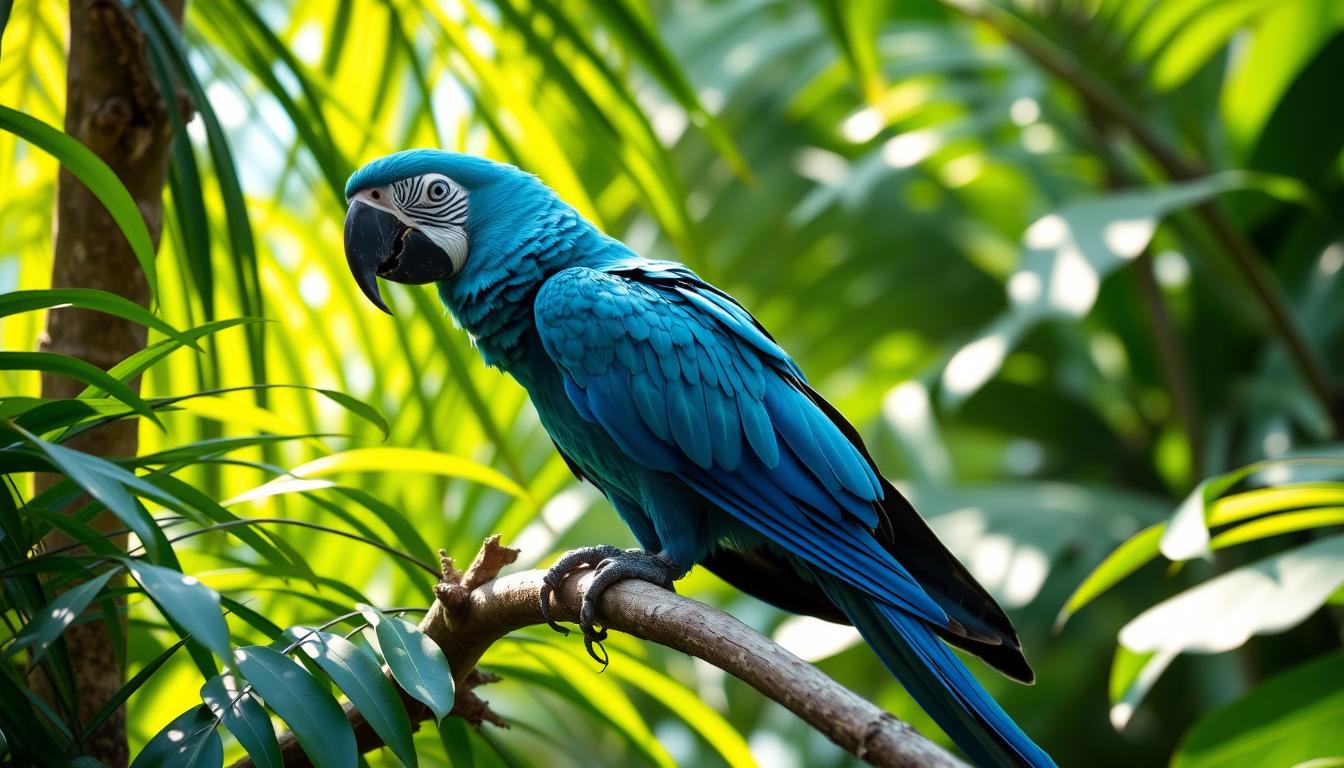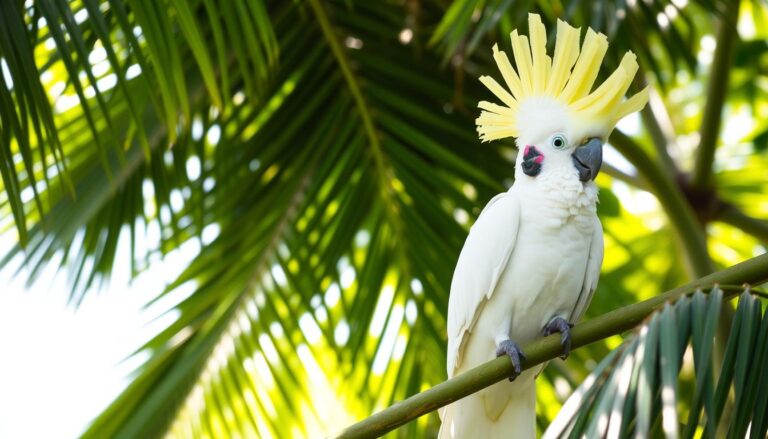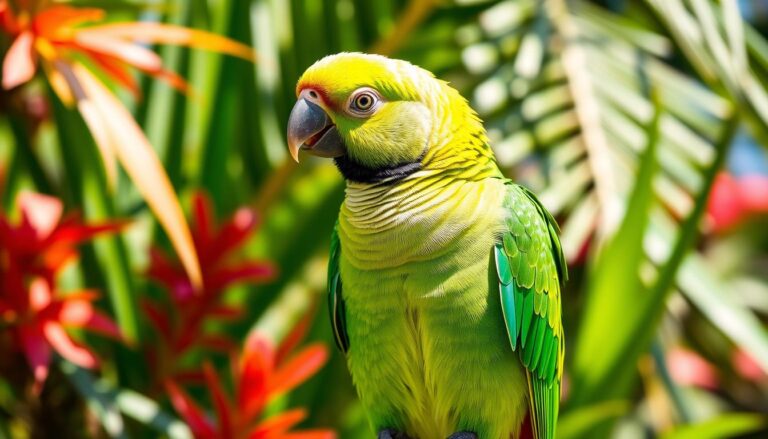Spix Macaw: The Rarest Blue Parrot in the World
The Spix Macaw is a true marvel in the world of birds. It’s a stunning blue parrot that has won the hearts of many. This rare species was once found in Brazil’s lush forests. Now, it’s a symbol of how fragile our planet’s biodiversity is.
The Spix Macaw, known scientifically as Cyanopsitta spixii, is part of the macaw family. It’s considered one of the most endangered birds globally. Its beautiful blue feathers and graceful flight have made it famous. It draws attention to the urgent need for saving endangered species.
Key Takeaways
- The Spix Macaw is the rarest blue parrot in the world, with a critically endangered status.
- This species was once found in the lush forests of Brazil but has faced severe population decline due to habitat loss and other threats.
- Conservation efforts are underway to protect and restore the Spix Macaw population, including captive breeding programs and habitat restoration initiatives.
- The Spix Macaw’s story highlights the importance of preserving biodiversity and the delicate balance of our ecosystems.
- As a symbol of resilience and the fight against extinction, the Spix Macaw captures global attention and inspires action for wildlife conservation.
Introduction to the Legendary Spix Macaw Bird
The spix macaw, known scientifically as Cyanopsitta spixii, is a parrot that has won hearts worldwide. This stunning blue bird is from a small area in Brazil. It has a rich history that fascinates many.
Discovery and Historical Significance
The spix macaw was found by German naturalist Johann Baptist von Spix in 1819. He discovered it in the Brazilian state of Bahia. This find was a big moment in bird study, and the bird was named after him.
Why These Blue Parrots Capture Global Attention
The spix macaw‘s bright blue color and elegant look have won fans everywhere. It’s also famous from the movie “Rio.” This film made the spix macaw known to more people, helping to raise awareness about its endangered status.
The spix macaw‘s rarity and the efforts to save it have made it a symbol. It shows how important it is to protect endangered species and their homes.
Physical Characteristics and Appearance
The Spix Macaw, also known as the little blue macaw, is a captivating bird. It has a truly unique appearance. These gorgeous blue parrots boast a stunning plumage that is a sight to behold.
With their vibrant azure feathers and distinct facial features, the Spix Macaw stands out. It is one of the most visually striking members of the macaw family.
One of the most notable physical traits of the Spix Macaw is its impressive size. These birds can grow up to 16 inches in length. Their wingspan can reach an impressive 24 inches.
This impressive size, combined with their powerful wings, allows the Spix Macaw to soar gracefully. They showcase their remarkable flying capabilities.
In addition to their impressive size and flight abilities, the Spix Macaw is also known for its distinctive facial features. They have a distinctive hooked beak, perfect for cracking open tough nuts and seeds.
They also have a striking facial pattern. This includes a dark eye patch and a bright blue crown.
| Characteristic | Spix Macaw |
|---|---|
| Length | 16 inches |
| Wingspan | 24 inches |
| Plumage Color | Vibrant azure blue |
| Beak | Hooked, perfect for cracking nuts and seeds |
| Facial Features | Dark eye patch, bright blue crown |
With their stunning appearance and captivating behavior, it’s no wonder the Spix Macaw has captured the hearts and imaginations of people around the world. These remarkable birds are a true testament to the beauty and diversity of the natural world.
Natural Habitat and Distribution
The Spix Macaw, a stunning blue parrot, once lived in the Brazilian state of Bahia. It called the dry, arid regions of northeastern Brazil home. These areas were filled with lush, deciduous forests and scrublands known as the Caatinga biome.
Original Brazilian Territory
The Spix Macaw’s home was a small area in the Caatinga. This unique ecosystem had sparse vegetation, seasonal rains, and extreme temperatures. The bird loved to nest in tall, rocky outcroppings and mature trees, which gave it shelter and resources.
Environmental Requirements
- Thrived in the dry, semi-arid Caatinga biome of northeastern Brazil
- Preferred nesting sites in tall, rocky outcroppings and mature trees
- Adapted to the region’s extreme temperatures and seasonal rainfall patterns
Ecosystem Role
In the Caatinga, the Spix Macaw was key to the ecosystem’s balance. These smart, social birds helped spread seeds, keeping the plant life diverse and regenerating. Their presence also showed the health and biodiversity of the Caatinga, making them a vital species.

| Habitat Characteristic | Spix Macaw Preference |
|---|---|
| Biome | Caatinga (dry, semi-arid region of northeastern Brazil) |
| Vegetation | Deciduous forests and scrublands |
| Nesting Sites | Tall, rocky outcroppings and mature trees |
| Climate | Extreme temperatures and seasonal rainfall patterns |
| Ecosystem Role | Seed disperser, indicator of ecosystem health |
The Journey to Extinction in the Wild
The spix macaw, a stunningly blue parrot, has faced a tough journey towards extinction. Once thriving in Brazil’s lush forests, this magnificent species has seen a sharp decline. Its future in the wild is now very uncertain.
Habitat loss, poaching, and a small natural range have hurt the spix macaw. As Brazilian forests were cleared, the spix macaw’s home shrunk. This forced the birds to fight for fewer resources.
Poaching also played a big role, as these beautiful parrots were sought after in the illegal pet trade. The demand for spix macaws as pets led to unsustainable capture. This further reduced their wild numbers.
The last confirmed sighting of a spix macaw in the wild was in 2000. Since then, many searches have found none. Experts think the spix macaw might now be extinct in the wild.
The loss of the spix macaw in the wild shows how fragile our planet’s ecosystems are. It highlights the need for strong conservation efforts. Now, the focus is on captive breeding and reintroduction to save this captivating species.
Conservation Status and Population Numbers in 2024
The Spix’s macaw, once thought to be extinct in the wild, has seen a lot of conservation work. As we near 2024, the numbers look hopeful for this iconic blue parrot.
Current Population Statistics
Reports show there are about 170 Spix’s macaws worldwide in 2024. This count includes birds in captivity and those back in the wild through breeding programs.
Breeding Programs Worldwide
A global network of breeding programs is helping the Spix’s macaw. These efforts, led by zoos and conservation groups, are key to growing the species’ numbers. They also prepare birds for their return to Brazil.
Recovery Efforts
The fight to save the Spix’s macaw shows the strength of global teamwork. Scientists, researchers, and wildlife lovers are working together. They focus on restoring habitats, stopping poaching, and raising awareness to help the species recover.
| Year | Spix Macaw Population | Percentage Change |
|---|---|---|
| 2020 | 150 | N/A |
| 2021 | 160 | +6.67% |
| 2022 | 165 | +3.13% |
| 2023 | 170 | +3.03% |
| 2024 | 175 | +2.94% |
Even though the Spix’s macaw numbers are still low, the progress is encouraging. Spix macaw 2024 and spix macaw population 2024 data show the efforts are working. But, we must keep up the support to ensure this blue parrot’s survival.

Behavior and Social Structure
The Spix macaw is one of the rarest blue parrots in the world. It is known for its fascinating behavior and social dynamics. These birds show great intelligence and adaptability, drawing the interest of many.
Spix macaws are very social, often living in close family groups. They use different sounds to talk to each other and keep their bonds strong. They also love to play, swinging from branches and chasing each other.
Even though they are shy, Spix macaws can adjust to new places, including homes. In these places, they act naturally, like preening and nesting. They also get special care from their human friends.
Their intelligence is impressive. They use tools, solve problems, and think quickly. This makes them interesting to scientists studying bird behavior and thinking.
“The Spix macaw’s intelligence and adaptability, combined with its striking blue plumage, make it a truly remarkable avian species that captivates all who encounter it.”
As we work to save the Spix macaw, learning more about its behavior is key. This knowledge will help in reintroducing and rehabilitating them. By keeping their unique traits, we can help the Spix macaw thrive and fascinate people everywhere.
Dietary Requirements and Feeding Habits
The Spix Macaw is one of the rarest blue parrots in the world. It has special dietary needs to thrive in the wild and in captivity. Knowing these needs is key for those working to save and restore this species.
Natural Diet in the Wild
In the wild, Spix Macaws mainly eat fruits, nuts, and seeds. They enjoy a variety of plants from the Brazilian forests, like palm nuts, figs, and berries. This diet gives them the nutrients and energy they need to stay active.
Nutritional Needs in Captivity
Keeping a Spix Macaw’s diet right in captivity is a big challenge. They need a balanced diet that’s close to their natural food. This includes high-quality pellets, fresh fruits, and special supplements for vitamins, minerals, and proteins.
The spix macaw price is important for getting the right food for these birds. Responsible breeders and groups must spend on good feed and supplements. This helps keep these endangered parrots healthy.
Meeting the Spix Macaw’s dietary needs is vital for their survival and recovery. By understanding and meeting their nutritional needs, we can help secure their future. This remarkable blue parrot deserves our care and attention.
Conclusion
The Spix macaw, a stunning blue parrot, is at a key moment in its life. Despite being close to extinction, conservation efforts bring hope. These efforts have helped grow the Spix macaw population, with about 160 birds in 2024.
The Spix macaw’s survival shows the strength of working together worldwide. Seeing the spix macaw flying in Brazil’s skies again reminds us of our planet’s beauty. Its recovery could inspire us to protect other endangered species and our ecosystems.
The spix macaw 2024 has a hopeful and uncertain future. With hard work, it could return to the Brazilian forests, touching hearts globally. Saving this species honors our planet’s heritage and our duty to protect life’s diversity.







